Disclosure: Meeple Mountain received a free copy of this product in exchange for an honest, unbiased review. This review is not intended to be an endorsement.
In Maps of Misterra, you’re playing as explorers, mapping out the island’s landscapes—landscapes that might change from turn to turn, say Mountains become Forests. That’s because there’s a difference between terrain types that are ‘confirmed’ and what your sponsor has said they want to see on your map. Score the most points at the end of the game and you’ll be the winner.
If that sounds a bit confusing, stay with me. The mists will part as we get the game to the table.

Cartographers At the Ready
You’ll place the large central board in the middle of the table, then hand each player their own smaller version of the map. Depending on the player count, a number of Forests will be placed, full-color side up. (More on this soon.)
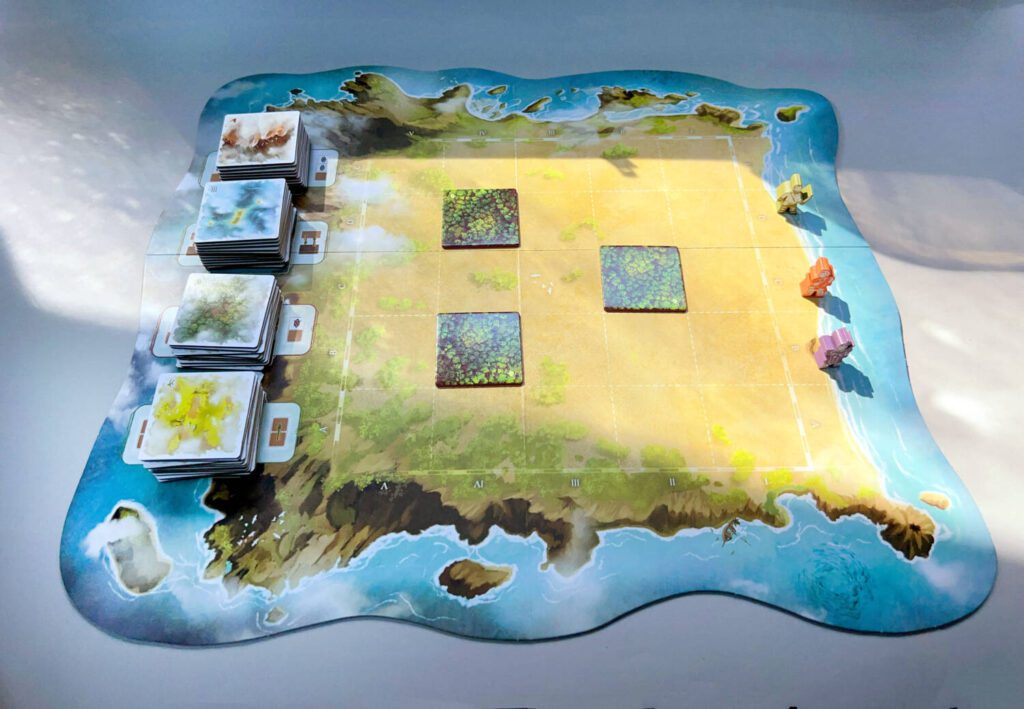
Each player will also get a Cartographer of their choice and three Claim tokens in their matching color.
At the top of the board, place the four stacks of terrain tiles full-color side down. Then shuffle the stack of narrow Sketch cards for your number of players. You’ll then lay out five of these, face up, alongside the board.

Give each player four Presumption cards. You’ll choose two of these and return the other two to the box. These cards would be better named, “What My Sponsor Wants to See” cards, but “Presumption” is shorter.

My Map, Your Map, and Our Map
On your turn, you’ll actually take two full turns. Each one will start with the option of moving your Cartographer on the main map board. At the start of the game, this will mean moving onto the shoreline. You’ll then select one of the Sketch cards and place it by the main board on a square orthogonally adjacent to your position on the board.

In Maps of Misterra, you’re only able to see one orthogonal square away (unless you’re on a Mountain, which means you can see two orthogonal squares away).
You’ll then take two matching tiles from the top of the board and place them, misty side up, on those squares on the main board. Then, you’ll take the Sketch card and place it on your personal player board in the same position.

Moving onto each terrain type gives you special benefits—for the most part. As previously stated, moving onto Mountains means you can see twice the usual distance. Moving into a Lagoon means you can replace one of the face-up Sketch cards with one from the top of the deck. Steppes allow you to slide across the tile to an orthogonally connected tile. (And if that next tile is also a Steppe, you keep on sliding.) Forests, however, are dead ends. Walk into a Forest tile and that part of your turn ends.
Terrain tiles on the main board are either confirmed or unconfirmed. A misty sided tile is unconfirmed. It’s just what one player wanted it to be—or what their sponsor wanted it to be. If you can see an unconfirmed tile on your turn, you can decide it’s a completely different terrain type. Don’t like that Lagoon and want it to be a prairie-like Steppe? Play a Steppe Sketch card on that square and swap that misty-sided Lagoon out for a misty-sided Steppe. It’s that simple.
The player who placed that Lagoon Sketch card on their player board keeps the Lagoon where it is. It’s only the Lagoon tile on the shared main board that gets changed. Players can swap out the Misty-sided tiles out over and over again until another player ‘sees’ the same terrain type on that square. When they place a matching Sketch card on the same square, they’ll flip the tile over to its full-color side, showing it has been confirmed.

You cannot change a confirmed tile on the main board. They can, however, be changed on your player board (to your advantage).
But, wait, I hear you asking. I’m confused: doesn’t that mean my player board is going to look different from the main board? You betcha it will. And that’s where Maps of Misterra shines. When it comes time for scoring, you’ll score two points for every Sketch card square on your player board that matches what’s on the main board. However, you’ll usually be able to score more points by having your player board match your sponsor’s requests on the Presumption cards.
Instead of playing a Sketch card, you can claim the terrain type you’re on by placing one of your matching tokens on the main board. During end game scoring, you’ll earn two points for each matching terrain type that is orthogonally connected to that tile. Only one player can claim a terrain type per game.
The end of the game is triggered when either the main board is filled with confirmed tiles, or there are no more Sketch cards available, or when a player has covered all the squares on their player board. You’ll score for your Presumption cards, claimed terrain tiles, and the squares on your player board that match the main board. You’ll also lose one point for each empty square on your player board. Count up the points and the player who has the most wins the game.
Recording Observations
My first two plays of Maps of Misterra were frustrating. I kept forgetting that the Presumption cards only counted against my player board—an issue that, as it turned out, was shared amongst everyone in my player group. The concept isn’t difficult, but making the mental distinction took some getting used to.
Keeping your Cartographer on the move is an important part of the game. You won’t be able to ‘see’ all the squares on your player board without constantly being on the move. You’ll also need to be flexible, as there is an element of luck in the draw of Sketch cards available on your turn. If one of my Presumption cards scores for every Lagoon tile I have on the edge of my map and none of the Sketch cards have Lagoons, I have to change my plans.
The boards and tiles are all thick cardboard. The Cartographer meeple and tokens are all wood and fit the size of the board well. The artwork is clear, with the misty and clear sides of the tiles distinctive from one another. There’s a very helpful scoring pad that we used in each of our plays that made scoring a breeze.
We did wish the Presumption cards came with some explanatory text printed on them. (There’s certainly enough room on them.) While I’m all for language-independent graphics, they only work if they’re clear. In every game, we had to pass around the rule book to reference at least one of our Presumption cards to see what it meant.
In the time between plays, I’ve thought about that critical difference between the maps. In our last two games, one of the players in my weekly group has won by choosing two Premonition cards that worked well together. He all-but disregarded the confirmed terrain of the main board throughout the game, selecting only those Sketch cards that worked with his Premonition cards. (Admittedly, this took a combination of skill and luck.) With matching tiles only being worth two points, I think this may be the key to winning the game. I’m looking forward to playing again to test this strategy.
Our initial games took over an hour to play. However, our latest games have only taken about 40 minutes, which is just right for this type of game. Maps of Misterra is a challenging, mid-weight game with an interesting mechanic. At first, I wasn’t sure about it, but subsequent plays have shown that it deserves its space on my game shelves.
Maps of Misterra is a bit of Cartographer Truthiness I’m happy to indulge in.




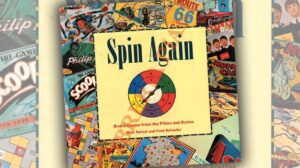
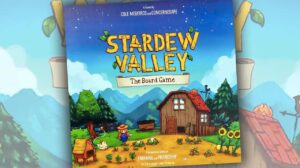
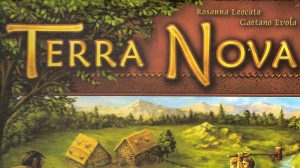
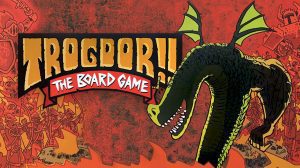




Add Comment